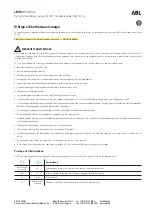
3
against shorting the output terminals and reversing the output terminals on a battery. It is
equipped with an IEC-320 type power input module with fuse holder and a spare fuse. A 6'
long detachable power cord with NEMA 5-15P plug is provided for use in North America.
Other power cords can be ordered with plugs designed to mate with receptacles in other
countries. There is an input voltage selection switch located above the input module to
select between 115 V~ and 230 V~. The standard output cable is 3' long with insulated
boots and spring clips. There is one indicator light on the front panel. It lights green to
indicate when power is applied and, when a battery is attached, that the charger is in float
mode. It lights yellow when the unit is charging the battery. It lights red to indicate a fault
condition (shorted or reversed output connector). The unit has a full metal enclosure to
ensure field reliability.
This unit is designed to automatically switch into a single stage, float charge mode when the
battery is charged. A single stage, parallel charger version is available for keeping a battery
fully charged when used with a permanent or intermittent parallel load. The use of an
optional low voltage cut out is recommend when using parallel loads. This unit is not
designed to operate as a standalone power supply.
OPERATING INSTRUCTIONS
Before using this battery charger, make sure it is compatible with your battery. Refer to the
ratings on the battery charger, the specifications in this manual, and your battery
documentation.
Determine the battery polarity. Most batteries identify the positive terminal with a "
+
" sign
or the color
red
and identify the negative terminal with a "
-
" sign or the color
black
. Connect
the red insulated output clip to the positive battery terminal and connect the black insulated
output clip to the negative battery terminal. If the charger is provided with a polarized
connector, make sure your battery connector is wired to match the output connector.
The input voltage setting is displayed on the selection switch on the back of the unit. If this
setting must be changed, make sure the power cord is disconnected while operating the
switch. Operating the switch while power is applied may cause damage to the switch or
charger. Plug the power cord into a properly grounded outlet which supplies the correct
input voltage.
The indicator light should now be yellow, indicating that the charger is operating and in
charge mode. The yellow charge light will stay on until the battery is about 95% recharged.
At this point the indicator will turn green and the battery may be used. The battery should
be left connected to the charger for an additional three hours to ensure a 100% recharge.
To insure a full charge and to help your battery keep its full capacity, we recommend the
battery be left connected to the charger, in float charge mode, until ready to use. The
battery may be left connected to the charger indefinitely, in float charge mode, without
danger of overcharging.
CHARGING NOTES AND TIPS
For safer and more efficient charging, batteries should be charged with higher voltages
when cold and lower voltages when warm. This unit incorporates automatic temperature
compensation of the output voltage. It will increase the charge voltage in cold conditions
and decrease charge voltage in warm conditions. For this feature to work properly, the
battery and charger should be located in the same environment (allow the battery and
charger to stabilize at room temperature before charging). Initially, the charger open circuit
voltage may read a little high until its internal temperature warms during operation, thereby
lowering the voltage.























